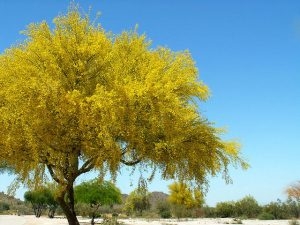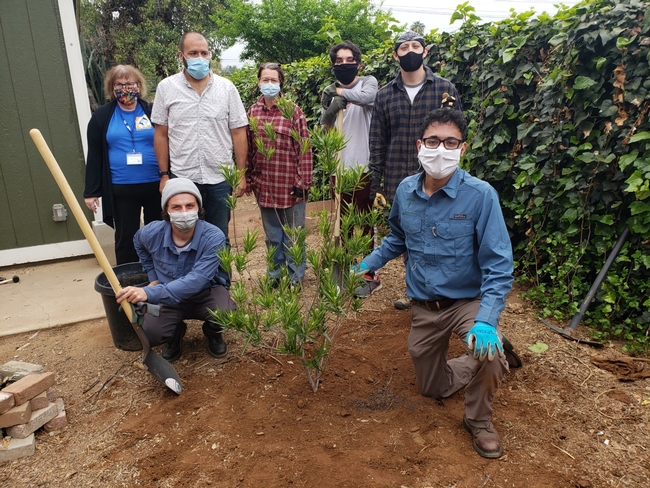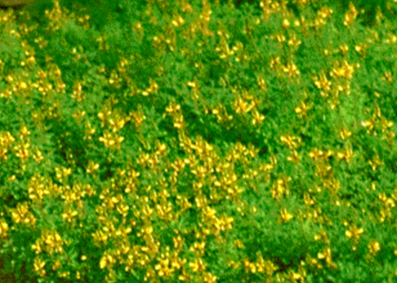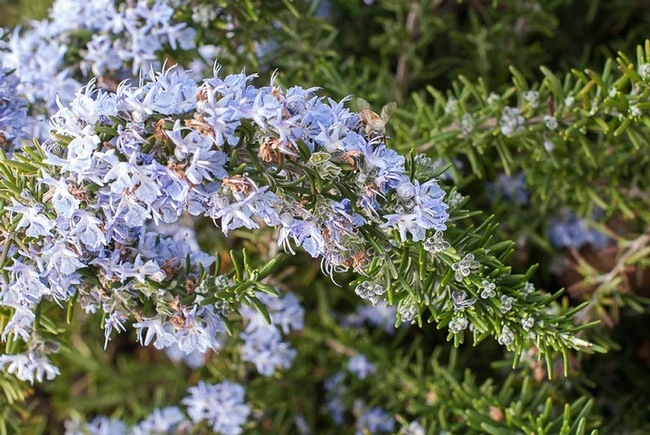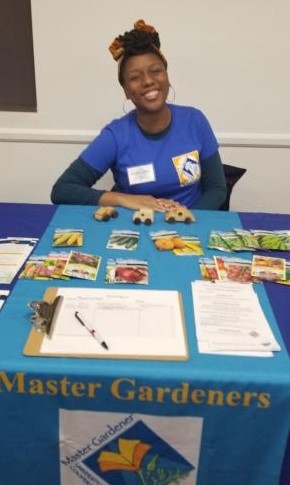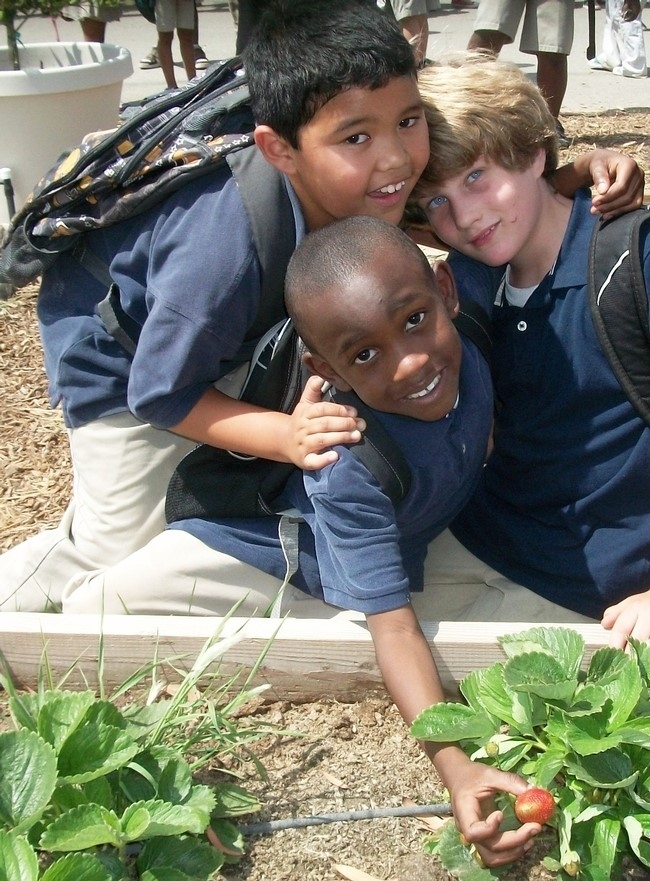- Author: Janet Hartin
It's only right that our University of California Cooperative Extension (UCCE) San Bernardino County Master Gardener ‘Trees for Tomorrow' team of volunteers are our featured ‘Spotlight' Master Gardeners for September, 2021. They provided vital education to Redlands residents receiving gratis trees through a multi-partnership grant obtained by Inland Empire Resource Conservation District Manager Mandy Parkes. 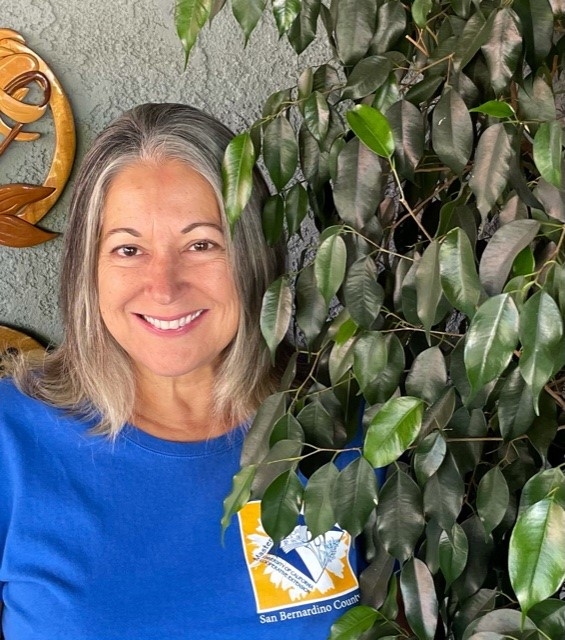
It's an honor and privilege to recognize UCCE San Bernardino County Master Gardener Project Leader Debbie LeDoux and her dedicated team of 'Trees for Tomorrow' volunteers: Zhibo (Sandy) Anderson; Consuelo (Connie) Davis (pictured); Pam O'Connell; Gail Sefl; and Husam Yousef. These dedicated Master Gardeners were tasked with helping residents select, plant and care for drought, heat, and pest tolerant trees. (Species including Chilopsis linearis 'Bubba', and Pistacia x 'Red Push' were selected due to their excellent performance in our University of California/United States Forest Service research project as 'climate-ready' trees able to withstand harsh conditions related to our changing climate.) Working with a team of California Climate Action Corps volunteers, civic leaders, Common Vision Coalition, and other groups, nearly 100 trees were planted in yards and parks lacking the preferred 25% tree canopy cover.
Trees can cool urban heat islands by 50 degrees Fahrenheit or more during spring and summer, creating welcome oases in hot inland communities. With spring 2021 temperatures so high they broke previous records on multiple dates, the project is especially timely and necessary.
In addition to proper tree selection, trees require the right long-term care. Master Gardeners will continue to provide advice on irrigation, pruning, fertilizing and pest control to residents receiving trees long after the trees are planted. This is critical since an average urban tree lives less than 20% of its potential lifespan due largely to poor care. The long-term engagement of Master Gardeners with residents is as important as is selecting the right species.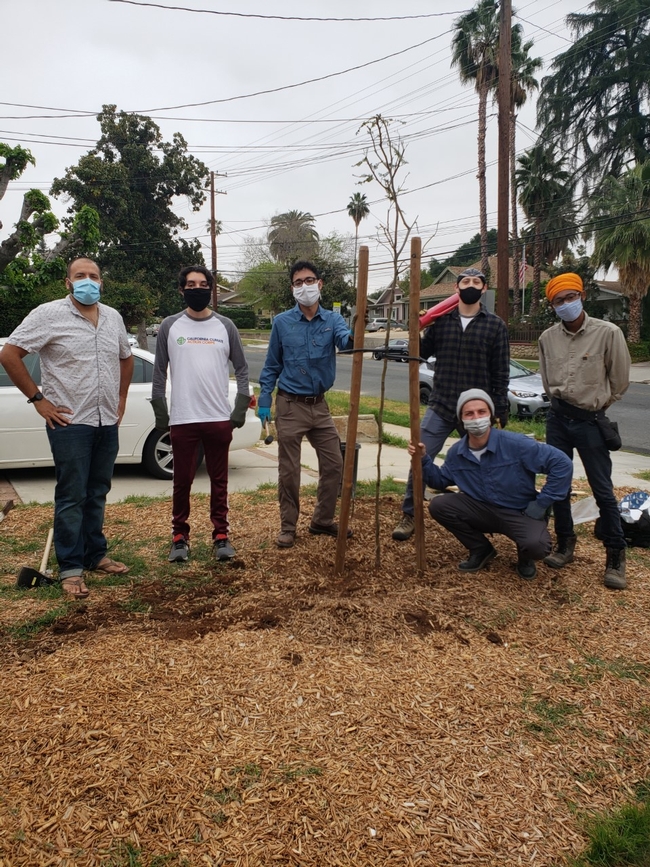
UCCE Master Gardeners are all volunteers, giving of their time and talents to enhance the quality of life for individuals and families who call San Bernardino County their home. Each Master Gardener is required to complete a rigorous 18-week training class complete with exams, class projects, and lots of participation! Due to COVID-19, volunteers had to master key horticultural concepts during the first ever all on-line training class. Only recently have they been able to meet fellow Master Gardener graduates and, in some cases, the Redlands residents they mentored through the tree canopy enhancement project. They truly exemplify community spirit and all it takes to successfully work together under adverse conditions. Kudos to each and every one of you from Master Gardener Coordinator Maggie O'Neil and myself! You are creating a cooler, greener and healthier environment for our children's children.
I asked the honored Master Gardeners their thoughts on the project. Here's what they had to say:
“The Redlands tree canopy project was the best volunteer project ever. In the midst of Covid-19, horrific politics and way too many good byes, it was a truly joyous experience. The legacy of being a part of the group that promoted healthy sustainable trees, knowledge of how to plant and care for them, tips on maintaining their health and beauty was the absolute best. For me as a Master Gardener, it was so much fun. I loved the site walks and getting to help our participants select the perfect sustainable trees for their properties. What started as a one-on-one visit often expanded to an enlarged group of neighbors and extended family. I got to give out many handouts and publications and promote our excellent Master Gardener program. I got to share our helpline email and phone numbers. I love the fact that I have been asked to revisit sites to see how great they are doing (once to make sure the tree did not look funny!). I receive emails every now and then asking me questions and showing me pictures of "Our Trees.” So much fun, Janet. Thank you. By far the coolest project ever! Pam O'Connell
------------------------------------------------------------------------------------------------------------------
There are a few things that really made an impact on me.1) It was rewarding to attend the Zoom presentation you developed that provided education to various professionals on the importance of planting sustainable trees. I found it to be open and inclusive allowing for good interchange of ideas and concerns.2) There are many beautiful trees that are sustainable.3) Reaching out to the community to offer beautiful, sustainable trees was a worthwhile way to show how various organizations can work together to benefit the community while trying to improve our environment.4) When dealing with homeowners that belong to an HOA, additional time and communication may be needed to assist them in obtaining approval for trees from their HOA's. Connie Davis
-----------------------------------------------------------------------------------------------------------------
"I see tree planting efforts similar to what a trend of the future is to combat climate change and increase awareness of the importance of trees and tree canopies in our neighborhoods. Not only that but I see this project expanded to other cities in the county of San Bernardino. The continuity of this project is so valuable so that we can see the positive impact on the environment and the well-being of San Bernardino residents in the coming decades. I see this important work being organized and well-coordinated by involving the appropriate stakeholders at all stages of the planning project. It is about time to give back what we have taken for tens of years!" Husam Yousef 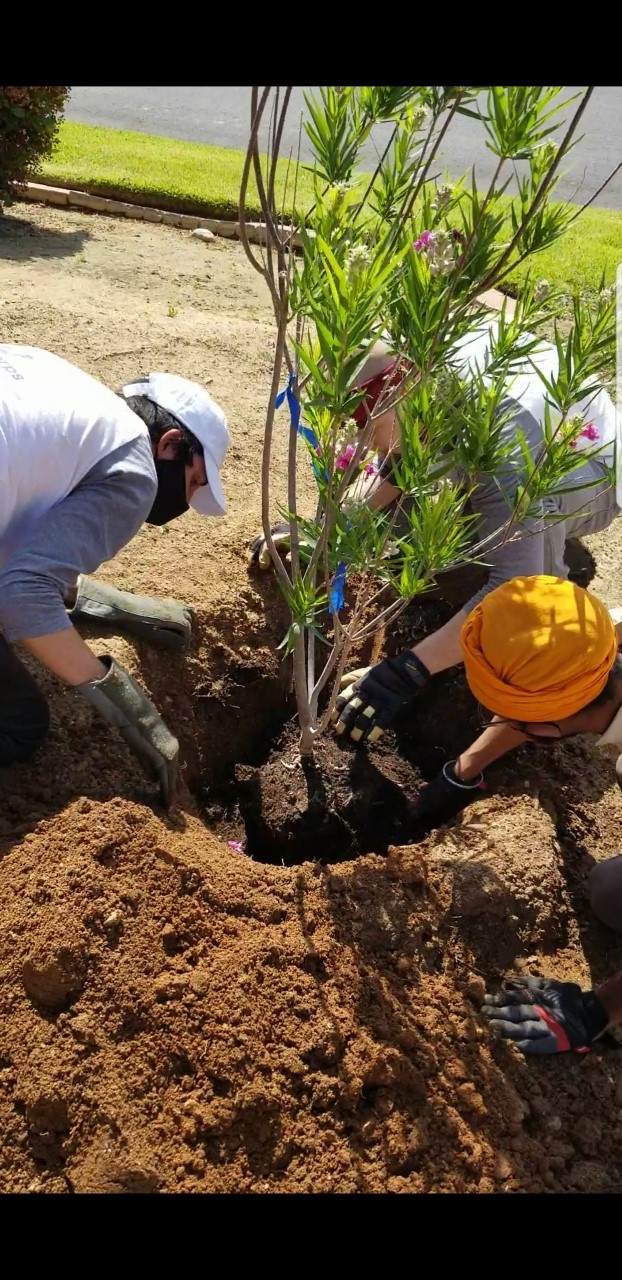
------------------------------------------------
It was rewarding to see local homeowners excited about planting trees and grateful for the program providing them. Gail Sefl
---------------------------------------------
THANK YOU ALL! Janet Hartin and Maggie O'Neill
- Author: Janet Hartin
an plants help cool our urban heat islands and mitigate impacts of climate change in our inland cities? I've been interested in measuring the temperatures of living and non-living surfaces for some time. Preliminary results are in! Use of dark asphalt, synthetic turf,
What can you do?
Take care of your trees, shrubs, groundcovers, and lawns to maximize their ability to cool the surrounding environment. In the same experiment described above, the coolest temperatures occurred in lawns growing in the shade of a mature tree. This is due to living plants cooling the environment during the process of transpiration. Non-living surfaces don't provide this natural air-conditioning. While many people believe lawns waste water, it's important to fully consider the alternative of replacing a water-efficient warm-season lawn like Bermuda or Buffalograss with either dark mulch or no living plants at all. The lawns are much cooler! Our previous UC studies determined that it's often not the lawns (and other sprinkler-irrigated plants like groundcovers) that waste the water, it's the uneven coverage (low distribution uniformity) of most sprinkler systems, coupled with not applying the right amount of water seasonally.
However, If you're tired of your high maintenance lawn and want to ditch your lawnmower, fertilizers, and pesticides, consider a low-maintenance drought-resistant groundcover that has similar cooling effects without the need for chemical inputs.
Plant drought-tolerant groundcovers
Here are just a few examples:
Peruvian Verbena (Verbena peruviana). This groundcover grows to only 1" tall and sports dark green leaves and white to pinkish (several hybrids available) blossoms that bloom from spring through fall. It spreads quickly and requires little water once established.
Dwarf Rosemary (Rosmarinus prostratus) This particular rosemary species is a low-growing groundcover. It is a great choice for rock gardens, reaching only 6 inches tall. It produces purple flowers in the summer and attracts pollinators and can be used for culinary purposes (bottom).
Gold Dalea (Dalea capitata). This semi-deciduous evergreen grows between 8" to 1' tall and has small yellow flowers that bloom in spring and fall and a pleasant scent. It is very heat tolerant and great for urban heat islands (parking lots, etc.) as well as planters and paths (lower right).
For more information on trees, groundcovers, shrubs, and vines suitable for your own home, contact a UC Cooperative Extension Master Gardener volunteer in your county using this link: https://mg.ucanr.edu/FindUs/
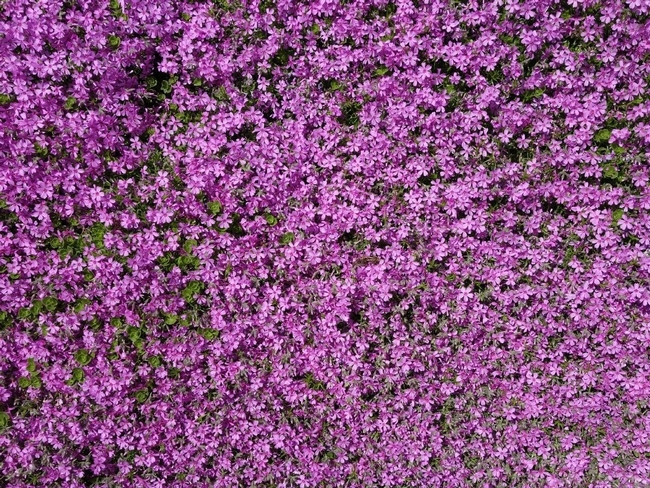
- Author: Janet Hartin
In your landscape, your trees and edibles should come first under drought and water restrictions! If there just isn't enough water to go around, your lawn and flowers should be sacrificed instead. Trees are our most valuable landscape resource and take years to maximize their benefits (shade, cooling, habitat/ecosystem enhancement, carbon dioxide storage, energy conservation, pollution filters, etc.). 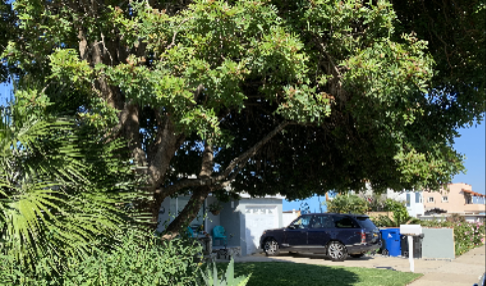
Just a few slow, deep waterings with a garden hose away from the trunk and slightly beyond the drip line will keep established trees alive, even during summer. Remember to keep trunks dry!
Here are some other tips:
• Spread and maintain 2-4” of mulch around garden plants and trees (3-4” for wood chips, 2” for pebbles, decomposed gravel, etc.) keeping it a few inches away from tree trunks. (Note: dark colored dyed mulches should be avoided in inland and desert areas due to their high surface temperatures that can > 60 degrees F hotter than living plants and lighter colored mulches.)
• Water early in the morning when soil evaporation is minimal.
• Control weeds. They compete with other plants for water.
• Avoid fertilizing. Nitrogen increases growth and the need for more water.
• Don't plant new plants during the summer when temperatures are highest. Even drought-resistant native and non-native plants need regular watering their first season.
- Author: Janet Hartin
Please consider making a tax-deductible donation on Friday, June 4 ("Big Dig Day" or anytime!) to support the efforts of our 220 UC Cooperative Extension San Bernardino County Master Gardener volunteers.These highly trained, dedicated, and passionate volunteers help over 35,000 county residents each year grow food in home, school, and community gardens; cool urban heat islands through the proper selection and care of drought-efficient landscape plants; and, enhance their quality of life through participating in outdoor activities. Even during COVID, the Master Gardener volunteers provided education at more than 150 educational activities, adapting in-person training to online opportunities. These volunteers provide over $260,000 of services each year! 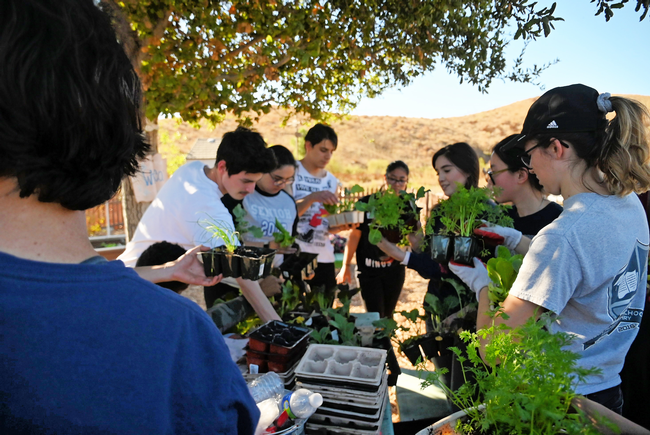

Options for 'on the spot' donating include making a one-time gift, a recurring (monthly gift) or cherishing the memory of a loved one through a tribute gift. 
Share your support for the UCCE San Bernardino County Master Gardener program on social media by including #BigDigDay and #giveback in your posts.
Other ways to give: (information provided by Kelly Scott, major gifts officer, UC ANR)
There are a variety of planned gift options that will allow you to meet your philanthropic and financial goals. You can make a significant impact by supporting the UC Master Gardener Program through your estate plans, for instance by making a bequest. Donors may also establish income-producing gifts such as charitable gift annuities or charitable remainder trusts, which benefit them during their lifetimes with up-front income tax savings and often at a higher return. (Please contact Kelly Scott at kdscott@ucanr.edu or (530) 750-1307 for more information on this option.)
Stock and Appreciated Securities
Avoid capital gains tax and claim a federal tax charitable deduction for the full appreciated value of long-term (held more than 1 year) securities (stocks, bonds, mutual fund shares). In order to qualify, gifts must be transferred directly from your brokerage account to the Regents of the University of California. (Please contact Kelly Scott at kdscott@ucanr.edu or (530) 750-1307 for more information on this option.)
Real Estate/Personal Property
Gifts of tangible property or other assets that represent value may offer you tax benefits while also enabling you to support our program. Examples include real estate, equipment, collections, and artwork. If you have a gift of this kind. (Please contact Kelly Scott at kdscott@ucanr.edu or (530) 750-1307 for more information on this option.)
Please help us spread the word and share this blog with others who have benefited from the help of a Master Gardener volunteer.
We hope you will join us on June 4!
Thank you in advance for your generosity.
- Author: Janet Hartin
During the drought, your trees should come first! Because many well-maintained trees don't reach their prime until their 4th or 5th decade, it's important to keep them watered during the drought and water restrictions. Older trees absorb higher levels of carbon dioxide, do a better job of cooling urban heat islands and providing shade. They also filter air and water pollutants, reduce soil and water erosion, provide habitat for wildlife, enhance privacy, beautify neighborhoods and parks, enhance property values, and even improve mental and emotional health. Trees are worth saving! The price of starting over is just too steep.
Recognizing early signs of drought stress is important because irreversible damage can occur that no amount of watering will correct. If you cash in your grass for a water district rebate, remember to water any trees that relied on water from the lawn sprinklers. This is because tree roots grow laterally quite a distance, often well beyond the dripline of the tree under the lawn. Over time, start watering them more deeply and less often to encourage deeper roots and enhanced stability.
Just a few deep waterings in mornings or late evenings with a garden hose during spring and summer can keep a tree alive, even during a drought. Keep the trunk dry and water from the mid-dripline outward. Apply a slow steady stream of water, moving the hose to another section of the tree every 1-2 hours. Another inexpensive way to water your trees is to encircle them with soaker hoses that connect to a garden hose. The soaker hose should be in concentric rings about one foot apart starting two feet away from the trunk for a larger tree, closer for a more recently planted tree with a more confined root system.
Check trees regularly for these common symptoms of water stress:
• Wilting or drooping leaves that don't return to normal by evening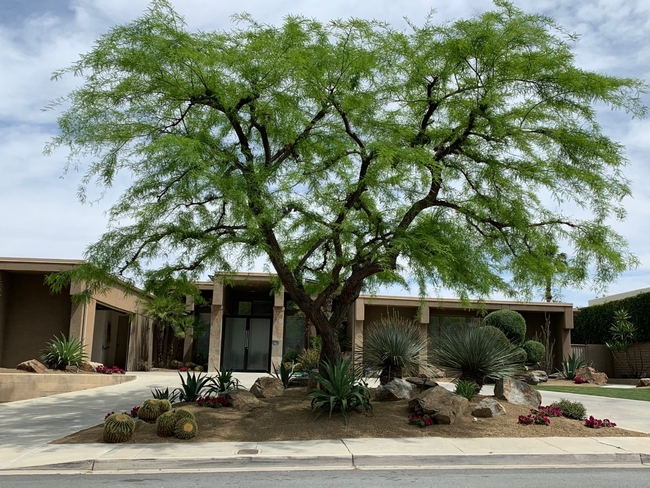
• Yellow, brown or sometimes gray leaves that may drop from the tree
• Small new foliage and stunted overall tree growth
Other ways to reduce tree water loss include:
• Keep weeds out (they compete for water
• Maintain a 3-4” of organic mulch or 2” layer of inorganic mulch (pebbles, decomposed gravel) around your trees, starting a few inches away from the trunk outward.
• Avoid fertilizing since that increases their water need.
• Do only necessary pruning (to remove dead wood and any dangerous limbs that look like they might fail) since this stresses the tree and can increase its water need.
--------------------------------------------
UC Resources at Your Fingertips:
Free Download Publications: https://anrcatalog.ucanr.edu
-Keeping Plants Alive Under Drought and Water Restrictions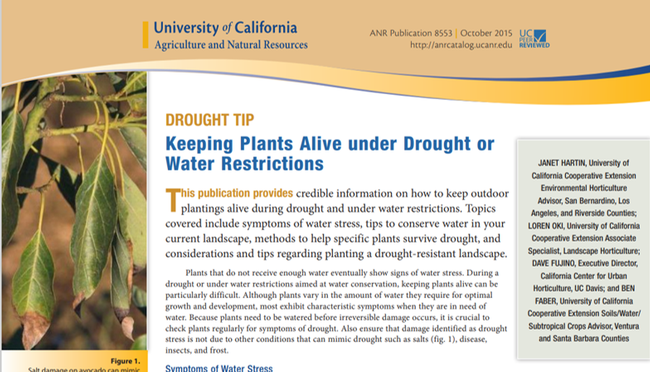
-Sustainable Landscaping in California
-Lawn Watering Guide for California
-Use of Graywater in CA Landscapes -
CA Institute for Water Resources: http://ciwr.ucanr.edu/ (blogs, climate-smart ag, podcasts, etc.)
UC Cooperative Extension Master Gardener Program:
For more drought tips and help with your home gardening questions, contact a UCCE Master Gardener volunteer. Find your local program atucanr.edu/FindUs/
